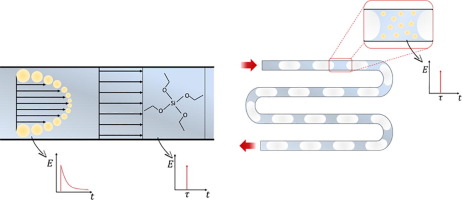Chemical Engineering Journal ( IF 15.1 ) Pub Date : 2018-04-01 , DOI: 10.1016/j.cej.2018.03.167 Luca Panariello , Luca Mazzei , Asterios Gavriilidis

|
A mathematical model for the liquid-phase synthesis of spherical nanoparticles in continuous flow micro- and milli-reactors was developed, accounting for residence time distributions (RTD). These distributions were derived for the reactants and the particles involved in the synthesis. The kinetic parameters needed to describe the reactions were calculated from experimental data available in the literature from batch reactors, with the aid of population balance modelling. They were subsequently used, without further modification, to simulate the synthesis in flow reactors via population balance modelling, averaging the nanoparticle properties at the reactor outlet using the reactor RTDs. The model was employed to describe the synthesis of silica nanoparticles as a case study, and validated against flow reactor results from the literature. The results demonstrate direct RTD effects and indirect diffusion-induced effects on the evolution of the particle size distribution during the flow synthesis. The former are created by the inherent widening of the RTDs, due to the different residence time experienced by each fluid element, leading to a broadening of the particle size distribution. The latter are induced by the difference in diffusivity between nanoparticles and liquid reactants, which leads to different dispersion processes in the reactor for the different components of the reaction mixture. These effects appear as the major cause of particle size distribution difference between (single phase) flow and batch syntheses.
中文翻译:

模拟连续微反应器中纳米粒子的合成:扩散和停留时间分布对纳米粒子特性的作用
建立了在连续流微反应器和毫反应器中液相合成球形纳米颗粒的数学模型,该模型考虑了停留时间分布(RTD)。这些分布是针对反应物和参与合成的颗粒而得出的。描述反应所需的动力学参数是根据人口平衡模型,从文献中可从间歇式反应器获得的实验数据计算得出的。它们随后未经进一步修改就用于通过种群平衡模型模拟流动反应器中的合成,使用反应器RTD对反应器出口处的纳米颗粒性质进行平均。该模型作为案例研究用于描述二氧化硅纳米颗粒的合成,并针对文献中的流动反应器结果进行了验证。结果表明在流动合成过程中,直接RTD效应和间接扩散诱导效应对粒度分布的演变。前者是由于每个流体元素经历的不同停留时间而导致的RTD的固有加宽而产生的,从而导致了粒度分布的加宽。后者是由于纳米颗粒和液体反应物之间扩散率的差异而引起的,这导致反应器中反应混合物不同组分的分散过程不同。这些影响似乎是(单相)流动与批处理合成之间粒度分布差异的主要原因。前者是由RTD的固有加宽产生的,这是由于每种流体元素所经历的停留时间不同,从而导致了粒度分布的加宽。后者是由于纳米颗粒和液体反应物之间扩散率的差异而引起的,这导致反应器中反应混合物不同组分的分散过程不同。这些影响似乎是(单相)流动与批处理合成之间粒度分布差异的主要原因。前者是由RTD的固有加宽产生的,这是由于每种流体元素所经历的停留时间不同,从而导致了粒度分布的加宽。后者是由于纳米颗粒和液体反应物之间扩散率的差异而引起的,这导致反应器中反应混合物不同组分的分散过程不同。这些影响似乎是(单相)流动与批处理合成之间粒度分布差异的主要原因。这导致反应混合物中不同组分的反应器中的分散过程不同。这些影响似乎是(单相)流动与批处理合成之间粒度分布差异的主要原因。这导致反应混合物中不同组分的反应器中的分散过程不同。这些影响似乎是(单相)流动与批处理合成之间粒度分布差异的主要原因。



























 京公网安备 11010802027423号
京公网安备 11010802027423号